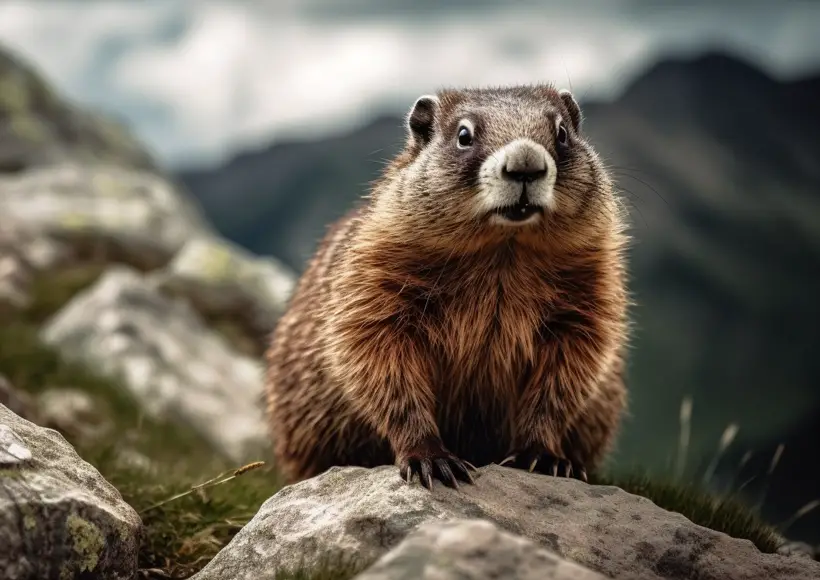What Sound Does a Marmot Make? An Overview of Marmot Vocalizations
Marmots are a group of ground-dwelling rodents found in various parts of the world, including North America, Asia, and Europe. These mammals are known for their robust build, short legs, and bushy tails and are closely related to squirrels and prairie dogs.
One fascinating aspect of marmot behavior is their vocalizations. It is important to know about their vocalization, which plays a critical role in their communication and survival. These are often found in numerous wildlife habitats and are considered an important part of the wildlife ecosystem.
Here, we will give a general review of marmot vocalizations, their meanings, and methods of use. Also, other additional information will be disclosed. So continue reading.
Overview of Marmot Vocalizations
So, what sound does a marmot make? The answer here needs to be briefly explained. In general, marmots use a variety of vocalizations to communicate with each other, including whistles, chirps, and calls.

These sounds can have different meanings depending on the context, and marmots use them for a range of social behavior. Have a look at each point in detail.
Whistles
One of the most common vocalizations made by marmots is the whistle. These sounds are produced by exhaling air through their teeth, ranging from short, sharp whistles to longer, more complex patterns.
Whistles are often meant to signal alarms or alert other marmots of potential threats. When a marmot spots a predator, it may emit a series of short whistles to warn other members of its colony.
A youtube video featuring a marmot whistle can be seen to understand it better:
Chirps
Another vocalization used by marmots is the chirp. These soft, trilling sounds are produced by vibrating their vocal cords and often mean they want social interactions. Mating or when greeting other members of their colony, they can produce such a sound.
Marmots can also chirp when they are in distress. You may watch this video to have a good idea of how marmots chirp:
Calls
Here, calls include an extensive range of sounds. We refer to this sound as a marmot’s call because it may be used for a variety of purposes, including alarming or calling other animals.
Marmots also use calls to communicate with one another. These can be heard in a variety of contexts, such as during play, feeding, or grooming. Calls are typically short and are used to convey a specific message.
For example, a marmot may use a call to signal to other members of its colony that it has found a source of food.
A youtube video featuring an example of calling can be seen here :
Marmot vocalizations are a fascinating aspect of wildlife behavior and can be an exciting subject for wildlife photography. By understanding the different sounds marmots make and their meanings, you can capture their unique communication and social behavior in your photographs.
How Marmots Use Vocalizations
Marmots are social animals that use vocalizations for various purposes such as predator avoidance, territoriality, and communication. We will now discuss all of these in a nutshell.

Marmot Communication Is an Essential Vocal Usage
Marmot communication is essential to their survival as they rely on it to warn other colony members of potential dangers, attract mates during the breeding season, and establish their territories.
Marmot Vocalize to Minimize Predator Attack
Marmot whistles are particularly important for predator avoidance. When a marmot detects a predator, such as a hawk or an eagle, it emits a loud and piercing whistle to alert other members of its colony. The whistle serves as a warning sign for other marmots to seek cover or run for safety.

Territory Dominance Can Also Be a Key Vocal Usage
Marmots may also use vocalizations to communicate aggression towards other marmots. When a marmot feels threatened by another marmot, it may emit a series of aggressive vocalizations. They may growl or bark to assert dominance and defend their territory.
These vocalizations can escalate into physical fights if the conflict is not resolved through vocal communication.
Marmot Uses Vocal During Breeding Seasons
Female marmots also use vocalizations during the breeding or mating season to attract potential mates. Marmot calls and whistles help in communicating the availability of a female marmot and her receptivity to mating.
During the breeding season, male marmots may produce more calls and whistles to attract mates.

Marmot vocalizations can vary between species and geographic locations. For example, yellow-bellied marmots found in North America make a distinctive chirping sound. But that is different from the chirping sound produced by alpine marmots found in Europe.
Marmot chirps are used for communication purposes, such as to identify other marmots or to signal danger.
If you’re curious about marmots, you might be wondering where they live and whether they make good pets. At RodentsFact, we have articles on where do marmots live and do marmots make good pets. Our article on where do marmots live covers the natural habitat and distribution of marmots, while our article on do marmots make good pets explores the suitability of marmots as pets and what you need to know before bringing one home. By learning about these aspects of marmots, you can gain a better understanding of their behavior and decide whether a marmot is the right pet for you.FAQs
To know more interesting factors about marmot vocalization, keep your eyes here.
Q: Can marmots communicate with other animals through their vocalizations?
Marmots primarily use their vocalizations to communicate with other members of their colony. However, some predators, such as birds of prey, may also be able to recognize marmot vocalizations and use them to locate their prey.
Q: How far can marmot vocalizations be heard?
It depends on the specific vocalization and the terrain but it is not specific. Whistles and calls can be heard up to several hundred meters away, while chirps are typically audible only at short distances.
Q: Can marmot vocalizations indicate distress?
Yes, marmot vocalizations can indicate distress. Marmots are known to make high-pitched whistles or chirping sounds when they feel threatened or alarmed, which can signal distress to other marmots in the area.
Conclusion
All in all, marmots use a variety of vocalizations to communicate with each other, including whistles, chirps, and calls. Whistles are often used to signal alarms or alert other marmots of potential threats, while chirps are produced to attract potential mates or indicate distress.
Marmot vocalizations play a critical role in their communication and survival, such as predator avoidance, territoriality, and breeding seasons. Moreover, marmot vocalizations can vary between species and geographic locations. However, some predators may also be able to recognize marmot vocalizations and they can use them to locate their prey.




